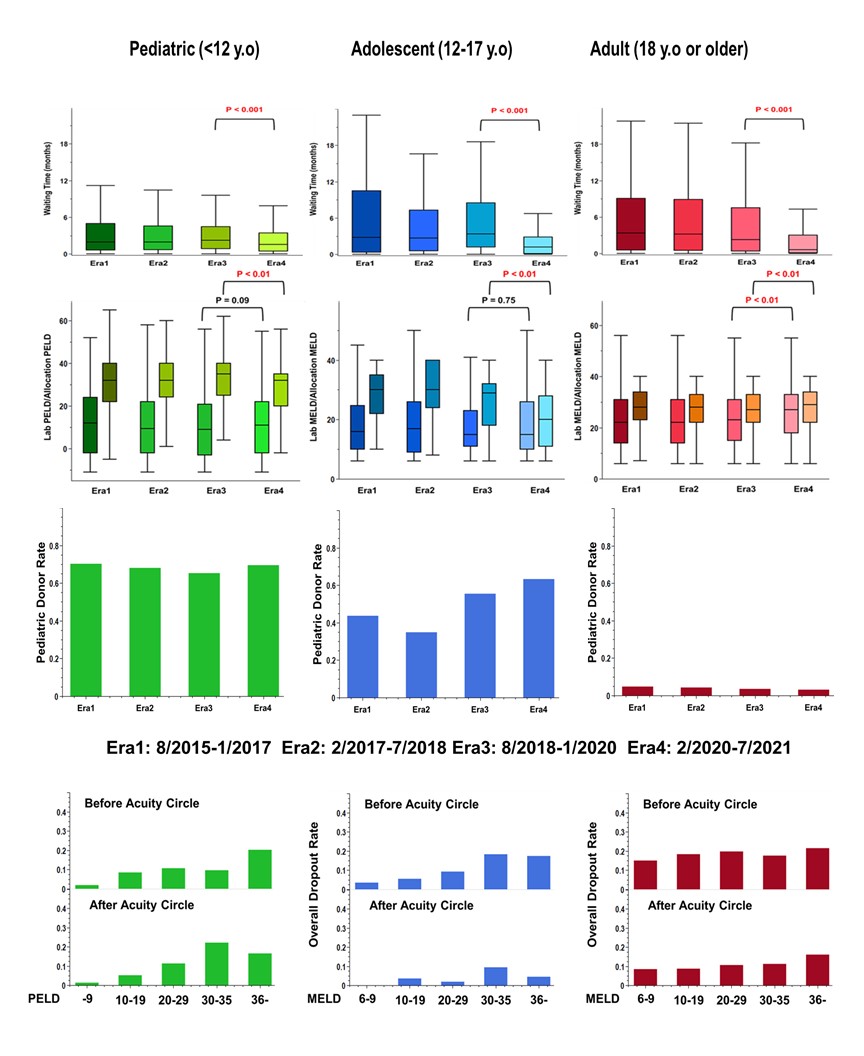Allocation Based on Acuity Circles: Effects on Pediatric Liver Allocation
Stanford University, Stanford, CA
Meeting: 2022 American Transplant Congress
Abstract number: 324
Keywords: Allocation, Liver transplantation, Pediatric
Topic: Clinical Science » Liver » 61 - Liver: Pediatrics
Session Information
Session Time: 5:30pm-7:00pm
 Presentation Time: 5:30pm-5:40pm
Presentation Time: 5:30pm-5:40pm
Location: Hynes Room 311
*Purpose: In February, 2020, UNOS implemented a new liver allocation system incorporating a combination of acuity based on MELD/PELD score and distance from the donor hospital, utilizing concentric circles of increasing distance (acuity circles). Furthermore, priority was given to pediatric patients on the waitlist for pediatric donors, with the national allocation of such organs to pediatric patients prior to offering the liver to an adult patient. This study examines the effects of the policy on liver allocation.
*Methods: OPTN data was analyzed for patients placed on the liver transplant waitlist between 8/2015 and 7/2021. Retransplant and multiorgan transplant patients were excluded. Patients were grouped according to age at listing concordant with OPTN stratification: pediatric < 12 years of age, adolescent 12-17, and adult 18 or older. Wait time, lab MELD/PELD score at the time of transplant, allocation MELD/PELD score usage of pediatric organ, and overall dropout ratio were assessed.
*Results: Waiting time for all age groups was reduced after the implementation of acuity circles (Fig. 1). However, adult patients experienced the greatest reduction in wait time compared to pediatric and adolescent patients. The average laboratory MELD/PELD score at transplant for pediatric and adolescent recipients was not affected by the change in policy. In contrast, the average allocation MELD/PELD score at transplant was reduced in both pediatric and adolescent groups. The total number of transplants increased in the adolescent population. However, the number of transplants in patients under 12 was not significantly different after the institution of acuity circles. Removal from the waitlist for reasons other than transplant was significantly decreased in the adult and adolescent populations. In the pediatric population, waitlist removals for patients with PELD score 36 or higher decrease. However, the dropout rate increased for pediatric patients with lower PELD scores, most notably in the patients with a PELD of 30-35.
*Conclusions: The new acuity circle allocation system for liver transplant patients has decreased the wait time for patients on the list awaiting transplant. This improvement is most notable for adult patients. Pediatric patients < 12 have experienced the least improvement in wait time, whilst adolescent recipients have benefited from a modest improvement between children and adults. The new allocation policy does little to improve waitlist dropout for pediatric patients < 12.
To cite this abstract in AMA style:
Kim MH, Sasaki K, Gallo A, Pham T, Melcher ML, Busque S, Esquivel C, Bonham C. Allocation Based on Acuity Circles: Effects on Pediatric Liver Allocation [abstract]. Am J Transplant. 2022; 22 (suppl 3). https://atcmeetingabstracts.com/abstract/allocation-based-on-acuity-circles-effects-on-pediatric-liver-allocation/. Accessed January 6, 2026.« Back to 2022 American Transplant Congress

